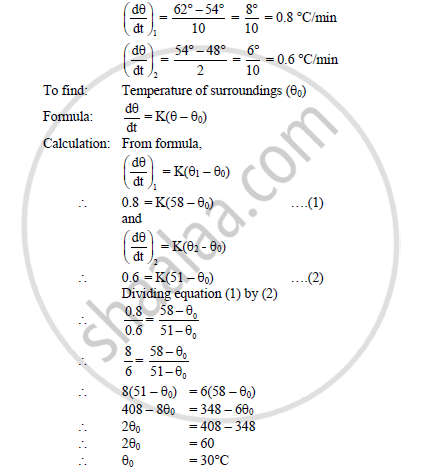Advertisements
Advertisements
प्रश्न
A body cools from 62°C to 54°C in 10 minutes and to 48°C in the next 10 minutes. Find the temperature of the surroundings.
उत्तर


Temperature of surroundings is 30°C
APPEARS IN
संबंधित प्रश्न
A metal sphere cools at the rate of 4°C / min. when its temperature is 50°C. Find its rate of cooling at 45°C if the temperature of surroundings is 25°C.
The light from the Sun is found to have a maximum intensity near the wavelength of 470 nm. Assuming the surface of the Sun as a black body, the temperature of the Sun is _____________.
[Wien's constant b = 2 .898 x l0- 3mK]
The susceptibility of magnesium at 300 K is 2.4 x 10-5. At what temperature will the susceptibility increase to 3.6 x 10-5?
What is the temperature of the triple-point of water on an absolute scale whose unit interval size is equal to that of the Fahrenheit scale?
The kinetic energy per molecule of a gs at temperature T is ________.
(a) `(3/2)RT`
(b) `(3/2)K_BT`
(c) `(2/3) RT`
(d) `(3/2)("RT"/M)`
It is said that mercury is used in defining the temperature scale because it expands uniformly with temperature. If the temperature scale is not yet defined, is it logical to say that a substance expands uniformly with temperature?
A spherical shell is heated. The volume changes according to the equation Vθ = V0 (1 + γθ). Does the volume refer to the volume enclosed by the shell or the volume of the material making up the shell?
The temperature of water at the surface of a deep lake is 2°C. The temperature expected at the bottom is
An aluminium sphere is dipped into water at 10°C. If the temperature is increased, the force of buoyancy
The atmospheric temperature in the cities on sea-coast change very little. Explain
The temperature of an object is observed to rise in a period. In this period
(a) heat is certainly supplied to it
(b) heat is certainly not supplied to it
(c) heat may have been supplied to it
(d) work may have been done on it
A railway track (made of iron) is laid in winter when the average temperature is 18°C. The track consists of sections of 12.0 m placed one after the other. How much gap should be left between two such sections, so that there is no compression during summer when the maximum temperature rises to 48°C? Coefficient of linear expansion of iron = 11 × 10–6 °C–1.
A circular hole of diameter 2.00 cm is made in an aluminium plate at 0°C. What will be the diameter at 100°C? α for aluminium = 2.3 × 10–5 °C–1.
A steel ball that is initially at a pressure of 1.0 × 105 Pa is heated from 20°C to 120°C, keeping its volume constant.
Find the pressure inside the ball. Coefficient of linear expansion of steel = 12 × 10–6 °C–1and bulk modulus of steel = 1.6 × 1011 Nm–2.
Answer the following question.
Clearly, state the difference between heat and temperature?
In hot summer after a bath, the body’s __________.
‘An object contains more heat’- is it a right statement? If not why?
Explain the meaning of heat and work with suitable examples.
Temperature and Heat are ______
One day in 1922, the air temperature was measured at 59°C in the shade in Libya ______.
Heat is measured in Celsius or centigrade.
Temperature in the form of energy.
Analogy
Evaporation:: 100°C: Freezing:: ______.
An earthen pitcher loses 1 gm of water per minute due to evaporation. If the water equivalent of the pitcher is 0.5 kg and the pitcher contains 9.5 kg of water, calculate the time required for the water in a pitcher to cool to 28°C from the original temperature of 30°C. Neglect radiation effects. The latent heat of vaporization in this range of temperature is 580 Cal/gm and the specific heat of water is 1 Cal/gm°C.
